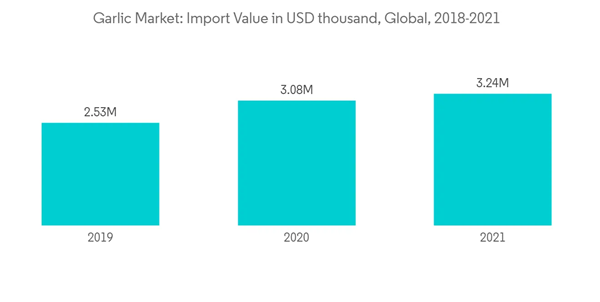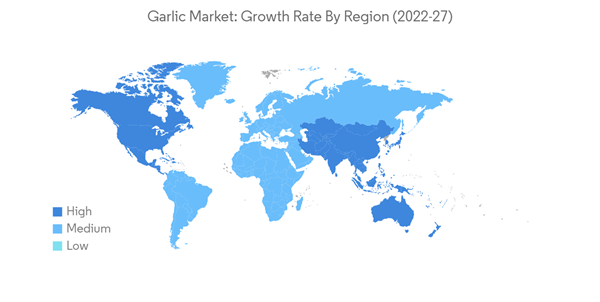The Garlic Market size is estimated at USD 539.35 million in 2024, and is expected to reach USD 616.20 million by 2029, growing at a CAGR of 2.70% during the forecast period (2024-2029).
The rising consumer demand for healthy convenience foods without compromising on their flavor and taste, coupled with the ability of garlic to remain shelf stable without altering its taste, drives its market growth. The demand for garlic is rising in various industries, such as processing industries, where the sales of pickles and curry products are high. Garlic is also widely used in herbal products, including pastes and medicines. The vegetable is also famous for its use as a flavoring agent in various cuisines. However, fluctuations in the price of garlic owing to various climatic and political factors are impeding its market growth.
Garlic is the most important crop in many Asian countries. Hence, Asia-Pacific dominates the global market in terms of the consumption of garlic. Garlic is consumed in every home and used in the processing industries. The huge demand for garlic powder due to its varied applications in the food and healthcare industries is driving the market. It is also used in various food preparations like chutneys, pickles, curry powders, curried vegetables, meat and meat product preparations, tomato ketchup, etc.
China is the leading producer of garlic, with production amounting to 20.7 million metric tons in 2020, followed by India with 2.9 million metric tons, according to the Food and Agriculture Organization. The other three top garlic-producing countries include South Korea, Egypt, and Russia.
Raw garlic is used in second-generation products like garlic powder, garlic salt, garlic vinegar, garlic cheese croutons, garlic potato chips, garlic bread, etc. Hence, the garlic market is expected to generate constant demand over the forecast period. Apart from this, garlic powder is used as herbal medicine. The boom in home cooking has boosted the demand for garlic, and subsequent volume increases have demonstrated that suppliers are up to the challenge.
According to a database published by ITC Trade Map, the global import value of garlic was USD 3,242,679 thousand in the year 2021, an increase of approximately 5.3% from the previous year. Garlic plays a very important and major role in world trade. This is demonstrated by the increase in the area harvested for the crop, accounting for 1,585,933, 1,629,344, and 1,631,869 hectares in 2018, 2019, and 2020, respectively.
As per FAO, in 2020, the total production of garlic globally was 28.1 million metric tons, an increase of approximately 3.9% from 2018. This substantial increase in the area harvested and production is due to the high demand for garlic owing to its varied applications in the food and healthcare industries, which are driving the market globally.
China is the world's largest producer and exporter of garlic. Its export for 2021 was valued at USD 2,033,585 thousand, an increase of approximately 2.1% from 2019, which was valued at USD 1,991,142 thousand, as per the ITC Trade Map data. Plantations in Jinxiang, Peizhou, Shandong, Jiangsu, Qixian Henan, Zhongmou, and Henan provide the current garlic supply. Indonesia is the top importer of Chinese garlic, followed by Vietnam and Malaysia. Europe is also a significant importer of garlic from China.
Garlic is the most vital crop in most Asian countries. Thus, the Asia-Pacific region accounts for a major share of the garlic industry. Garlic is consumed in almost every household and is also used in the food industry. Pickles, chutneys, curry powders, curried vegetables, meat and meat product preparations, tomato ketchup, and other meals all contain garlic; these are highly consumed in Asian countries. Such factors are contributing to the growth of the market.
This product will be delivered within 2 business days.
The rising consumer demand for healthy convenience foods without compromising on their flavor and taste, coupled with the ability of garlic to remain shelf stable without altering its taste, drives its market growth. The demand for garlic is rising in various industries, such as processing industries, where the sales of pickles and curry products are high. Garlic is also widely used in herbal products, including pastes and medicines. The vegetable is also famous for its use as a flavoring agent in various cuisines. However, fluctuations in the price of garlic owing to various climatic and political factors are impeding its market growth.
Garlic is the most important crop in many Asian countries. Hence, Asia-Pacific dominates the global market in terms of the consumption of garlic. Garlic is consumed in every home and used in the processing industries. The huge demand for garlic powder due to its varied applications in the food and healthcare industries is driving the market. It is also used in various food preparations like chutneys, pickles, curry powders, curried vegetables, meat and meat product preparations, tomato ketchup, etc.
China is the leading producer of garlic, with production amounting to 20.7 million metric tons in 2020, followed by India with 2.9 million metric tons, according to the Food and Agriculture Organization. The other three top garlic-producing countries include South Korea, Egypt, and Russia.
Garlic Market Trends
Increasing Demand for Garlic Due to Various Uses in Industries
According to WHO, regular intake of garlic may lead to a reduction in cancer risk. Garlic is consumed both fresh and used in the processing industry. It is also used in a wide range of food preparations like chutneys, pickles, curry powders, curried vegetables, meat and meat product preparations, tomato ketchup, etc.Raw garlic is used in second-generation products like garlic powder, garlic salt, garlic vinegar, garlic cheese croutons, garlic potato chips, garlic bread, etc. Hence, the garlic market is expected to generate constant demand over the forecast period. Apart from this, garlic powder is used as herbal medicine. The boom in home cooking has boosted the demand for garlic, and subsequent volume increases have demonstrated that suppliers are up to the challenge.
According to a database published by ITC Trade Map, the global import value of garlic was USD 3,242,679 thousand in the year 2021, an increase of approximately 5.3% from the previous year. Garlic plays a very important and major role in world trade. This is demonstrated by the increase in the area harvested for the crop, accounting for 1,585,933, 1,629,344, and 1,631,869 hectares in 2018, 2019, and 2020, respectively.
As per FAO, in 2020, the total production of garlic globally was 28.1 million metric tons, an increase of approximately 3.9% from 2018. This substantial increase in the area harvested and production is due to the high demand for garlic owing to its varied applications in the food and healthcare industries, which are driving the market globally.
Asia-Pacific Leads the Garlic Market
Asia-Pacific dominates the garlic market, with China alone accounting for more than 80% of the global garlic production. According to Food and Agriculture Organization (FAO), in 2020, garlic production in China was 20.8 million metric tons, compared to 20.7 million tons in 2019. China and India are the two largest garlic extract consumers in the Asia-Pacific. In these regions, it is employed as a basic ingredient in the making of various cuisines. Garlic is best grown in a climate with temperatures ranging from 12 to 24 degrees Celsius.China is the world's largest producer and exporter of garlic. Its export for 2021 was valued at USD 2,033,585 thousand, an increase of approximately 2.1% from 2019, which was valued at USD 1,991,142 thousand, as per the ITC Trade Map data. Plantations in Jinxiang, Peizhou, Shandong, Jiangsu, Qixian Henan, Zhongmou, and Henan provide the current garlic supply. Indonesia is the top importer of Chinese garlic, followed by Vietnam and Malaysia. Europe is also a significant importer of garlic from China.
Garlic is the most vital crop in most Asian countries. Thus, the Asia-Pacific region accounts for a major share of the garlic industry. Garlic is consumed in almost every household and is also used in the food industry. Pickles, chutneys, curry powders, curried vegetables, meat and meat product preparations, tomato ketchup, and other meals all contain garlic; these are highly consumed in Asian countries. Such factors are contributing to the growth of the market.
Additional Benefits:
- The market estimate (ME) sheet in Excel format
- 3 months of analyst support
This product will be delivered within 2 business days.
Table of Contents
1 INTRODUCTION
4 MARKET DYNAMICS
5 MARKET SEGMENTATION
Methodology

LOADING...










